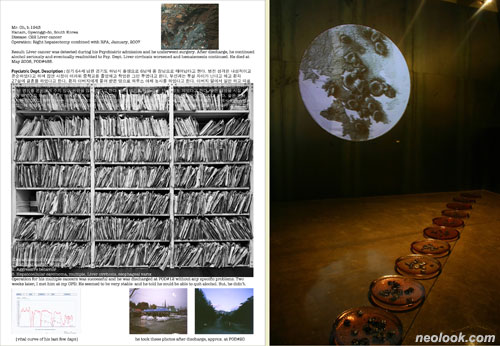- ● homepage
- ● archives
- ● restoration
- ● books
- ● big banners
- ● post board
- ■ neo's search
- ■ about us
- ■ 게재방법 안내
- 개인정보처리방침

- [email protected]
- Tel. 02_335_7922
- Fax. 02_335_7929
- 10:00am~04:30pm
- 월요일~금요일
- 3/3(월) 대체공휴일

생명은 아름답다 Life is very Beautiful
2013_1010 ▶ 2013_1206
초대일시 / 2013_1010_목요일_02:00pm
참여작가 강희안_김명호_김준현_노상익_노진아_로와정_다빌킴 찰스 다윈_마리아 지빌라 메리안_박재환_방명주_배윤호 어니스트 톰프슨 시턴_신미리_신사임당_엘레강스 펜클럽 염중호_윤정미_윤진영_이병찬_이원경_이재환&홍수 그라함 웨이크필드&지하루_정원연_최금수_장 앙리 파브르_한기창
주최 / KAIST 주관 / KAIST Art & Design위원회 감독 / 김정화(KAIST 문화기술대학원 교수) 기획 / 박수진(독립큐레이터)
관람시간 / 09:00am~06:00pm
한국과학기술원(KAIST) 대전시 유성구 대학로 291 KI빌딩 1,2층 museum.kaist.ac.kr
숨을 쉬는 모든 것은 생기의 싱싱함이 있고 마지막 숨에는 처연한 아름다움이 있다. 모든 살아있는 것들은 생과 사가 같이 있어 아름답고 자유로운 변이, 교접의 쾌락이 있어 만물은 생성되고 진화한다. 카이스트 숨(KAIST SHuM) 프로젝트의 두 번째 전시인 『생명은 아름답다 Life is very Beautiful』 는 생명에 대한 과학적 인문학적 예술적 접근을 통해 생명 다양성과 공생 네트워크를 다룬다. 『생명은 아름답다 Life is very Beautiful』 전은 "생물학"의 분류에 따라 "동물학", "식물학", "미생물학", "인간/인류학", 예술적 상상력으로 창조한 "가상생태계" 등 5개의 소주제로 전시하고, 생명과학과 인문학적 지평을 연 과학저술을 재가공하여 "과학인문학 아카이브"로 구성되었다.

- 김명호_생물학공방_웹툰 애니메이션_가변크기_2013 김준현_Tanacetum vulgare_판화지에 흑연, 디지털 프린트_60×45cm_2007

- 노상익_from the series RESULTs_C 프린트_90×70cm_2013 노진아_미생물(未生物) Series 中 미생물(1000000X)_ 단채널 비디오, 빔 프로젝터, 레진, 철가루_가변설치_2007
본 전시는 역사, 시간, 장소에 대해 오랫동안 조사하고 탐구해온 앎과 느낌의 체계인 생명의 역사, 진화사의 본질이 우발성(contingency)에 있음과 이 '우발성의 각도'(angle of tangence)에서 모든 만물은 생성되고 활동한다는 것을 보여주고자 한다. 박물학의 영역에 머물렀던 생물에 대한 연구는 1802년 생물학이라는 용어가 처음으로 사용되고, 1859년 다윈의 『종의 기원』 출간은 진화론이 생물학의 범주를 넘어서 다른 많은 학문, 우리 일상에도 많은 영향을 줬다. 특히 다윈은 인간을 포함한 자연의 모든 생물들이 하나의 생명체로부터 진화해왔다는 사실, 강력한 기형은 새로운 종의 탄생이며 또한 모든 생물의 진화에는 방향성이 없으며, 인간은 자연선택 과정의 우연한 결과물에 지나지 않다는 사실을 밝히고 있다. 즉 인간은 다른 자연에 비해 우월한 진보의 종이 아니며, 자연의 여느 생명과 다르지 않으며 모든 생명은 평등하다.

- 다발킴_수탉 머리의 여자 Woman of Cock Head _종이에 빨간 잉크, 컬러마카_47×39cm_2012 로와정_어딘가의 기념품-나무_3D 설치_가변크기_2013

- 박재환_Solar eclipse_단채널 비디오 프로젝션_00:02:18_2011 배윤호_하늘에 間 박물관_장편 hd 다큐멘터리_2010 매운땅_Redscape_디지털 프린트_120×40cm×4_2008 신미리_유기놈(BIOMAN)_애니메이션, 1920×1080p, 가변설치, 단채널 영상_00:04:50_2013_부분

- 염중호_예의를 잃지 맙시다_잉크젯 프린트_110×110cm_2012 윤정미_패류_The Shells_자연사 박물관_C 프린트_70×70cm_2001
본 전시의 주제인 "생명다양성과 공생 네트워크"는 인간을 포함한 지구상의 모든 생물들에게 속한 문제이자 진화의 관찰을 통해 자연에서 인간의 올바른 위치와 태도에 대한 것이다. 지구상의 모든 생물변화의 원동력은 생물체간의 계속적 상호작용, 공서(共棲), 상호 의존 등에 의한 것이다. 생물들은 투쟁에 의해서가 아니라 공생 네트워크에 의해서 끊임없이 진화해왔다. 공존은 진화 그 자체이다. "생명은 아름답다" 전시는 우리는 누구이며 어디로부터 왔으며 또 어디로 가고 있는가에 대한 범지구적 공생적 진화과정에 대한 과학적 관찰과 도전, 그리고 인간의 불안에 대한 사유와 성찰에 대한 것이다. ■ KAIST Art & Design Council

- 윤진영_HR109_곰팡이_C 프린트_100×120cm_2012 이원경_Flying_알루미늄, 와이어_가변설치_2011~13 이병찬_Urban Creature_Lafuta_비닐, 에어모터_가변크기_2013

- 정원연_꽃_실_가변크기_2013 한기창_혼성의 풍경_나무패널에 글루건_가변크기 2013 최금수_신양화소록_가변크기_2013 지하루&그라함 웨이크필드_Fluid Space: Endless Current_Interactive Immersive Installation_ 가변크기_2013
They are beautiful even until the last moment of their lives. The beauty of life is emphasized as there is death in the end. When each life is created, it evolves through the process of random mutation and reproduction. The theme of 『Life is very Beautiful』, the second exhibition of the KAIST SHuM project, is biodiversity and the symbiotic network among species. This exhibition aims to approach the theme of life from the artistic perspectives based on science and humanities. The 『Life is very Beautiful』 exhibition is comprised of six sub-topics: "zoology", "botany", "microbiology", "humanities", "virtual ecosystem", created by artistic imagination, and the "archive of science of humanities" presents scientific literature that encompass life science and humanities. This exhibition aims to show that the evolution of life is based on contingency and that the creation and evolution of life depend on the angle of contingency. Historically, the research of life was referred to as museology until 1802, when the term, 'biology' was first introduced to be used to indicate the study of life. Since Darwin's 『The origin of Species』 was published in 1859, the theory of evolution has influenced not only a wide range of studies, including biology, but also our everyday lives. According to Darwin, every species originated from a single species and dominant mutants became the start of new species. Therefore, the human race is a coincidental outcome of natural selection, as the evolution of life does not follow any specific directions. Furthermore, human beings are not superior to any other species and every life is equal according to Darwin. The theme of this exhibition "biodiversity and symbiotic network" is a critical issue for all species on earth, including human beings, and suggests what kind of attitude we need to have towards nature. The main drive for evolution is coexistence, constant interactions and mutual dependency among species. The creatures have evolved through their symbiotic network not through competition. Therefore, coexistence is the essence of evolution. The 『Life is very Beautiful』 illustrates the scientific investigation and challenge to the symbiotic evolution of creatures and intends to answer the question as to where we came from and where we are going. ■ KAIST Art & Design Council
Vol.20131014h | 생명은 아름답다 Life is very Beautiful展

